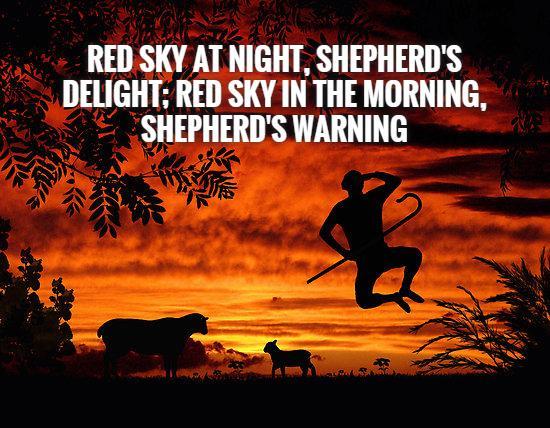Red sky at night, shepherd's delight; red sky in the morning, shepherd's warning

Red sky at night, shepherd's delight; red sky in the morning, shepherd's warning
The proverb "Red sky at night, shepherd's delight; red sky in the morning, shepherd's warning" is a traditional saying that has been passed down through generations. It is often used as a way to predict the weather based on the color of the sky at different times of the day. The idea behind the proverb is that a red sky at night indicates good weather the following day, while a red sky in the morning suggests that bad weather is on the way.The origins of this proverb can be traced back to ancient times when shepherds relied on their knowledge of the natural world to predict the weather. They would often look to the sky for signs of impending changes in the weather, as they needed to protect their flocks from the elements. Over time, this knowledge was passed down through oral tradition and eventually became a well-known proverb.
The science behind the proverb is based on the way that light is scattered in the atmosphere. When the sun is low in the sky, its light is scattered by particles in the atmosphere, creating the red hues that we see at sunrise and sunset. A red sky at night can indicate that high pressure is moving in, bringing with it clear skies and good weather. On the other hand, a red sky in the morning can be a sign of approaching storms or bad weather, as the red hues are caused by the sun shining through clouds that are moving in.
While the proverb is not always accurate in predicting the weather, there is some truth to it based on the science behind it. It serves as a reminder of the importance of paying attention to the natural world and being aware of the signs that nature provides. In a world where technology often dictates our lives, the wisdom of the proverb reminds us to stay connected to the world around us and to respect the power of nature.












 Friendship Quotes
Friendship Quotes Love Quotes
Love Quotes Life Quotes
Life Quotes Funny Quotes
Funny Quotes Motivational Quotes
Motivational Quotes Inspirational Quotes
Inspirational Quotes